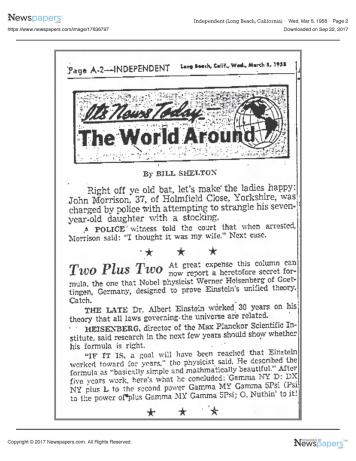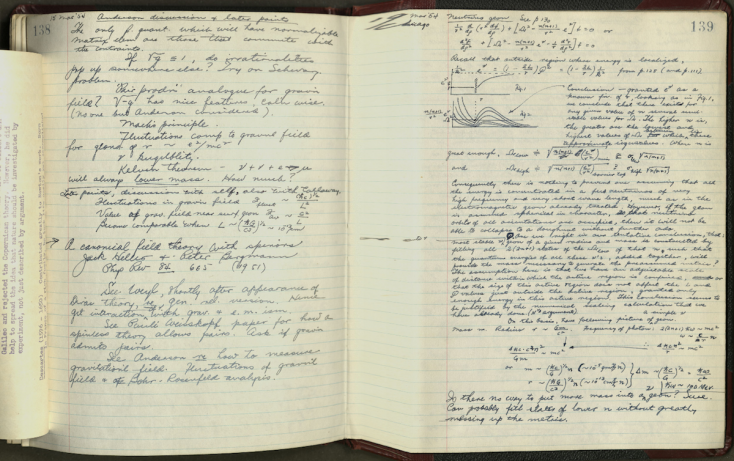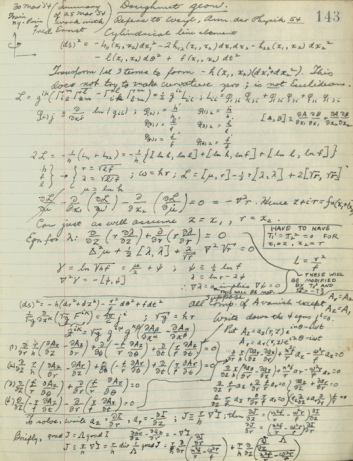In the Congress Hall of West Berlin, on April 25, 1958, as part of the centenary of the birth of Max Planck, Werner Heisenberg presented his recent breakthrough in what he called the ”non-linear spinor theory“ and what was already being called his “Weltformel” (see Fig. 1). This theory was supposed to explain, starting from just one fundamental constituent of matter and just one central equation, the manifold of observed microscopic particles and interactions and, ultimately, everything that could be constructed from them, i.e., the macroscopic physical world. It was supposed to be a “final theory.”
His lecture was the culmination of a series of presentations, which had been drawing considerable press coverage in Germany but also internationally. Phonetic transcriptions of Heisenberg’s formula appeared in American local newspapers (Fig. 2), and Heisenberg himself received exuberant fan letters stating the expectation that his “decisive invention would determine the fate of mankind.”
The reaction of Heisenberg’s physicist colleagues was not so enthusiastic. His theory was judged to be unable to reproduce well-established microscopic phenomena, or simply to be mathematically inconsistent. Despite his best efforts Heisenberg was unable to convince his doubters otherwise. He never retracted or backpedaled and continued to pursue the theory with a handful of collaborators. But he stopped presenting it as the next big thing to a wider audience, and the general public consequently heard little more about the further developments of Heisenberg’s theory.

Fig. 2: Article in the Long Beach Independent on Heisenberg’s theory. Source: Long Beach Independent, California, USA 1958.
The story of Heisenberg’s debacle has been told before. Some jeer at the fall of the great discoverer of quantum mechanics, who first failed at constructing an atomic bomb for the Nazis and then similarly failed in his attempt at a great Faustian comeback. Others are apologetic, claiming that Heisenberg had not anticipated the reaction of the media and simply used unfortunate wording in presenting an idea that was still far from completion. Others display pity at what the physicist Freeman Dyson in this context likened to “the death of a noble animal.”
What these narratives all have in common is that they find the reasons for Heisenberg’s failure in a personal shortcoming of his—be it his hubris, his naivety, or his age. It is one of the prime tasks of the history of science to move beyond such biographical narratives and ask: How was this possible? How could one of the most important scientists of the twentieth century delude himself into believing in a theory that by all (expert) accounts delivered wrong results, if it was even able to consistently deliver results at all?

Fig. 3: In search of a theory of quantum gravity at the Albert Einstein Institute. Image: Max Planck Institute for Gravitational Physics (Albert Einstein Institute; AEI).
This would be an interesting question even if Heisenberg had been the only one to try his hand at a final theory. But the search for a final theory has been a recurring motive in modern physics, from Albert Einstein’s rejection of quantum mechanics in favor of the search for a unified field theory, all the way to the contemporary attempts to construct a final theory of physics, the best known example being string theory. In all cases there has been strong resistance from other parts of the physics community, challenging the very viability of the approaches pursued or even contesting the possibility of a final theory in general.
In February 2018 the new research group Historical Epistemology of the Final Theory Program began its work at the MPIWG. It will study the history of these attempts starting from Heisenberg’s failure all the way to contemporary research. In the last decades, the search for a final theory has become virtually synonymous with constructing a theory that brings together the two revolutionary theories of the early twentieth century, general relativity, and quantum theory, in a unified framework going by the working title of quantum gravity. There is reason to believe that such a unified framework would indeed be able to encompass, at least in principle, all known physical phenomena. Quantum gravity is an active field of research at the Max Planck Institute for Gravitational Physics (Albert Einstein Institute), and the new group will consequently be working in close contact with physicists from this institute.

Fig. 4: Examples of calculations. John Archibald Wheeler Papers, Series V. Notes and Notebooks, Volume 40 (Relativity Notebook #2, 1953-1954). American Philosophical Society, Philadelphia.
Compared with modern string theory, which has been pursued for several decades by many physicists from around the world, Heisenberg’s early attempts seem somewhat laughable. But Heisenberg’s Weltformel is a valuable case study, as it offers insights into some of the central challenges faced by the final theory program in the second half of the twentieth century.
If one asks, for example, how Heisenberg could believe in a theory that failed to reproduce well-known phenomena, one needs to see that extracting results from modern microscopic physical theories (quantum field theories) is far from trivial and can in general only be done by using more or less trustworthy approximations. And if one moves outside the range of validity of these approximations the guesswork starts, and physicists could actually be of different opinion as to what a given theory was saying about the world—as was the case with Heisenberg’s Weltformel.

Fig. 5: Examples of calculations. John Archibald Wheeler Papers, Series V. Notes and Notebooks, Volume 40 (Relativity Notebook #2, 1953-1954). American Philosophical Society, Philadelphia.
But how then could Heisenberg construct his theory in the first place, if the connection with empirical data was so tenuous that it could hardly provide any input? Because theory construction by this time was so heavily constrained by the underlying mathematical formalism of quantum theory and Einstein’s relativity theory (special relativity, in this case) that all it took was two or three further assumptions in order to obtain a unique set of fundamental equations. In Heisenberg’s case, the central further assumption was that there would only be one fundamental constituent of matter from which all the known particles should be constructible.
This entire complex of theories that can be constructed without empirical input but then in turn have a hard time generating empirical output is a new, more historical way of looking at what philosophers of science have labeled post-empiricism. Understanding its historical genesis and its actual role in the development of the final theory program is one of the central aims of the new group’s research. This will help us understand not only how Heisenberg could go so wrong, but also provide novel ways of thinking about the challenges encountered by physicists looking for the final theory today.
